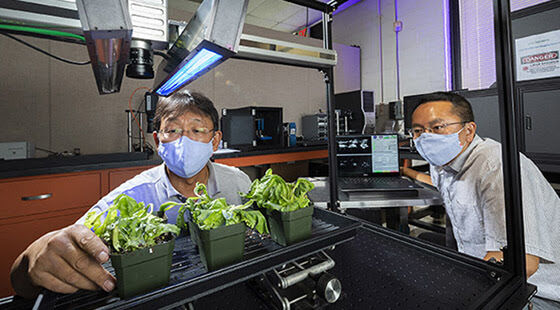“Keeping an eye on things” will take on new meaning when farming moves into space.
Researchers with USDA’s Agricultural Research Service are working with NASA to develop a new way for astronauts to watch over the fresh foods they will farm on extended space voyages. The plan is for astronaut farmers to employ machine vision technologies, such as “hyperspectral imagery,” to keep a sharp eye on their produce.
Hyperspectral imaging combines imaging and spectroscopy by taking pictures of a scene using dozens to hundreds of different wavebands of light. These wavebands may be visible to the human eye or regions of light that are invisible to the human eye, such as ultraviolet or infrared.
“ARS and NASA scientists are developing a hyperspectral imaging system to monitor plant health for astronauts to use in plant growth chambers for their pick-and-eat crops—such as fresh salad greens—to eat during future space missions,” said Moon Kim, agricultural engineer at the ARS Environmental Microbial and Food Safety Laboratory in Beltsville, Maryland.
According to Kim, a “hyperspectral image cube” is a stacked sequence of single-waveband images for the same spatial scene, in which each image shows the intensity of light detected for only one waveband. A multispectral example is a sequence of six single-waveband images spanning the rainbow: red, orange, yellow, green, blue, and violet.
Hyperspectral imaging provides data about how the materials in the image interact with specific wavelengths of light, which is often related to the chemical composition of the materials. This information can be used to identify differences in the subject material being imaged that cannot be seen by the human eye or detected from a normal color image, Kim said.
“For the NASA project, for example, plant leaves under drought stress may have areas differing in chlorophyll or moisture content, which can result in detectable differences in imaging signals but cannot necessarily be detected by eye or normal color imaging,” Kim said.
By collecting both spectral information with spatial information (e.g., feature shapes, sizes, relative positions), hyperspectral images can enable more complex analyses, such as differentiating between harmful disease symptoms and benign defects on the surfaces of fruits and vegetables.
Hyperspectral imagery research and application is not limited to future long-term space voyages; there are plenty of examples of its utility here on Mother Earth. Since the late 1990s, the ARS Instrumentation and Sensing Lab in Beltsville, Maryland, pioneered a benchtop line-scan system for hyperspectral imaging of food and agricultural products.
Researchers used the original lab system and its subsequent generations to examine samples and found useful wavelengths of light that could detect specific food safety problems, such as diseases or damage on fruits and vegetables that can be harmful to human health when affected foods are consumed.
Some of the most visible uses of hyperspectral imaging include testing raw fruits and vegetables for evidence of fecal contamination; an automated poultry inspection system for identifying chickens showing signs of systemic disease; and detecting contaminants in powdered food ingredients.
The hyperspectral imagery project was sponsored by the ISS U.S. National Laboratory, which works in coordination with NASA to fully utilize the orbiting laboratory to bring value to our nation through space-based research and technology development.



